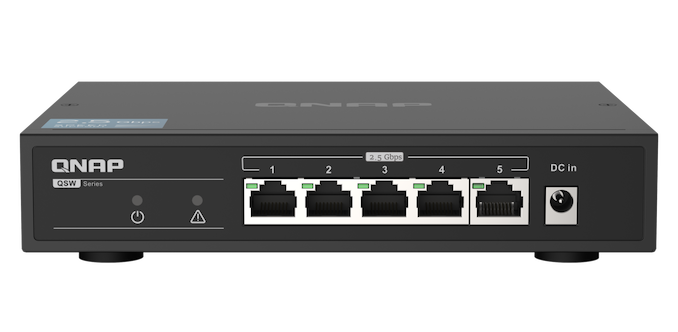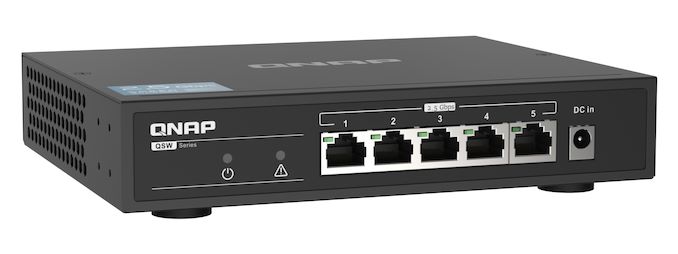At Last, a 2.5Gbps Consumer Network Switch: QNAP Releases QSW-1105-5T 5-Port Switch
by Ryan Smith on July 17, 2020 11:30 AM EST- Posted in
- Networking
- QNAP
- NBASE-T
- 2.5GBase-T
- Ethernet
- 2.5 GbE

After entirely too long of a delay, the wait for faster consumer-grade network switches appears to be coming to an end. This week QNAP launched its QSW-1105-5T switch, one of the industry’s first unmanaged 2.5Gbps (2.5GBASE-T) switches. The 5-port switch supports 2.5GbE operation on all five of its RJ45 Ethernet ports, and along with being unmanaged it is also fanless, allowing the switch to work maintenance-free and installed virtually anywhere. The QSW-1105-5T is already on sale in Taiwan for roughly $100, meaning that we’re looking at a price-per-port of about $20.
The saga of NBASE-T has been something of a long one. First introduced in 2016, the standard added the then-new 2.5GBASE-T and 5GBASE-T modes, which were designed to offer a series of intermediate steps between the existing 1Gbps (1000BASE-T) and 10Gbps (10GBASE-T) standards. By scaling down parts of the 10GBASE-T spec, the new standards would allow more modest – but still many times faster – network transmission rates than 1Gbps Ethernet, all the while being able to reuse existing Cat5e and Cat6 cabling. Overall, 2.5GBASE-T allows for 2.5Gbps Ethernet over Cat5e at the same 100m distances as 1Gbps Ethernet, while 5GBASE-T allows for 5Gbps speeds over 100m runs of Cat6, as well as quasi-official support for shorter Cat5e runs.
Given the technology reuse, moderately-priced NBASE-T network cards were quick to hit the market. However affordable switches have been a more complex matter: while the high initial price of NBASE-T was easy enough to eat on a single controller, multiplied over several ports on a switch, it quickly drove up the price tag. As a result, the market for NBASE-T switches has largely between split between downgraded pro gear like Netgear’s $70-per-port XS505M, and mixed-port switches like Asus’s XG-U2008, which offer just two 10G/NBASE-T ports along with a slew of Gigabit Ethernet ports. So cheap NBASE-T networking options have remained elusive, at least until now.
Thankfully, in the last year we’ve finally started seeing the slower of the NBASE-T modes, 2.5GBASE-T, sprint towards wide adoption. The 2.5Gbps standard is the cheapest to implement, and with recent controller releases from the likes of RealTek and Intel, 2.5Gbps controllers have quickly become a staple on high-end motherboards. Accordingly, with the price per port coming down for 2.5Gbps controllers, it’s also bringing down the price of whole switches. And this is where QNAP’s new switch comes in.
The QSW-1105-5T is one of the first switches to be released using these new generations of cheap controllers. Aimed squarely at the home and SMB markets, the switch doesn’t offer any frills such as network management, Power over Ethernet, or SFP+ ports. Instead it focuses on the things that matter for the home market: supporting 2.5Gbps networking in a small, passively-cooled switch that’s suitable to be neglected by being tucked under a desk or in a closet.
| QNAP QSW-1105-5T Switch | |
| Speeds | 100M/1G/2.5G |
| Ports (RJ45) | 5 |
| Managed | No |
| Power | 12 W |
| Dimensions | 3.4 x 18 x 14.5 cm |
| Cooling | Passive (Fanless) |
| Price | ~$100 |
As the first of what will undoubtedly be many 2.5G switches over the coming months, the QSW-1105-5T also gives us our first real look at what we can expect from this generation of switches as far as footprints and power consumption goes. Since it’s not carved from a pro-grade switch, the 18 cm x 14.5 cm switch is significantly smaller than earlier NBASE-T switches. And with a maximum power consumption rating of 12 W, we’re looking at power consumption of just a bit over 2 Watts per port, which is also a significant improvement over admittedly far more powerful switches.
All of which sounds unremarkable, and indeed that’s exactly what makes the QSW-1105-5T so interesting. The biggest barrier to wide consumer adoption over the last few years has been the cost – both in regards to the core technology and added frills – so we’ve been waiting for quite a while to see NBASE-T technology transition from pro-grade switches to cheap, consumer-grade gear.
Otherwise, QNAP’s new switch is further evidence that the PC industry is going to coalesce around 2.5Gbps Ethernet for the time being. Besides being the fastest standard to officially and fully support Cat5e cabling – which was installed in walls en masse when home networking first took off – it’s also the cheapest and lowest-power option. This is allowing it to be widely deployed not only in new motherboards and cheap USB adapters, but finally in switches as well – and making QNAP’s new switch a good match for all of those new NICs. And while I’d like to see cheaper 5Gbps and 10Gbps gear as well, 5GBASE-T seems likely to remain a premium (if not niche) option, owing to the higher controller costs as well as its higher power consumption, both of which remain big problems for a switch.
At any rate, QNAP’s 2.5Gbps switch is on sale now in Taiwan. The company has not announced release dates elsewhere, but judging from some of their previous product releases, I’d expect it to start showing up in North America some time in the next few months.
Source: QNAP

















98 Comments
View All Comments
Beaver M. - Tuesday, July 21, 2020 - link
Says the guy who claims home servers are not common.close - Thursday, July 23, 2020 - link
@Beaver M. for a very creative definition of "common". Or "home-server". It's clear that you have a fuzzy understanding of this which is why you come up with these fuzzy concepts and not a single concrete example of what would use 10G. As I said before, if you need it you already have it and it wasn't even cheap. If you don't have it you're just wanking around waiting for other people to pay for your wet dreams in order to drive price down. "Common" is to have WiFi, no "home servers" or nothing that can't work just fine on 1G. And if you actually have a home server that needs to be able to transfer things at 10G often enough to warrant the investment that's not common. The market proves that.For example I need to stream raw 16K 120FPS video to every one of my 140 16K TVs in each of my gold plated rooms (see, it excludes WiFi). That's like... 300GBps (capital B). So run along and start buying this until it's cheap enough for me to afford it.
Reflex - Monday, July 20, 2020 - link
1) Home servers are not common, although there is a prosumer market for NAS devices2) People who use them for mass storage are not loading them with NVMe drives
3) Gigabit can saturate most large HDD's
4) 2.5Gbit can saturate most SATA SSD's
5) SATA is dying because it's at the end of it's lifecycle and was replaced by other technologies. Also it's not really dying, so far there is no alternative for bulk storage in the consumer space.
Beaver M. - Tuesday, July 21, 2020 - link
1) They are very common. Else there wouldnt be such a huge market for them. Sorry.2) Why would they? Why is that relevant? RAID is very common though.
3) Nope. Large HDDs run 200 to 300 MB/s. That is far above 1 Gbit.
4) Almost all SATA SSDs run 550 MB/s. That is far above 2.5 Gbit.
5) Who are you trying to fool here? I was there when it happened. I saw all the people who cried for years for a new SATA standard because the old one was simply too slow for SSDs. It went as far as stuff as U.2 popping up, in hopes manufacturers adapting it. M.2 was a mess at the start too, mixed with SATA, because people still hoped for a new SATA standard. SATA Express popped up and was just a complete failure because it didnt go far enough.
close - Thursday, July 23, 2020 - link
1) They only need 1Gbps, "Else there wouldnt be such a huge market for them"."Huge"... lol. "Two inches of hard.... home-server baby". The market for home servers is insignificant by any measure. Most of it is RPis anyway. I'd say that you delude yourself thinking that your needs are relevant but I'm somewhat confident that these aren't needs even for you or you would have already addressed them instead of fantasizing here...
Samus - Friday, July 17, 2020 - link
I remember reading in 2016 when NBASE-T was pitched that the 2.5Gb speed was pitched at being the presumable maximum read speed for hard disks at the time, where most consumer and SMB data lies. The 5Gb sped was pitched as, you guessed it, the maximum throughput of SATA3. This all ignored the NVMe-based drives of the time because they conveniently didn't exist.Of course 4 years go by and NBASE-T is finally at a price to become mainstream, and is unsurprisingly "outdated" regarding current storage trends. Still, a 2.5x improvement is huge considering that is per port capacity. If you can upload a 10GBASE-T to a few NBASE-T ports, that gives a full 2500Mbits to each node on a small network from the host.
close - Saturday, July 18, 2020 - link
You're a regular driver, do you have a 1000HP EV?You're a regular media consumer, do you have an 8K TV?
You're a regular application user, do you have 256 CPU cores at 2 TB of RAM?
0)
I'm a regular user. Tell me what I need 10G for today. Think of a real scenario that would appeal to any regular user. Just please don't say "work from home" like someone above did ;).
Gigaplex - Sunday, July 19, 2020 - link
Lots of people are moving towards consumer grade NASes for storage. 1Gbit is a big bottleneck.Reflex - Monday, July 20, 2020 - link
What operations are regular users performing on a regular basis that can saturate 1Gbps? Consider also that these NAS's you speak of typically use HDD's, which gigabit can saturate.Gigaplex - Monday, July 20, 2020 - link
Gigabit can do ~110MB/s. A single spinning platter HDD can do more than that. An array of them (such as a consumer 4-5 bay NAS) easily exceeds that. My 3-drive array (Seagate Ironwolves) would still be bottlenecked by 2.5Gbit.